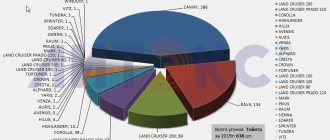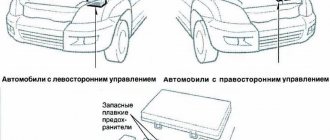The first generation of Toyota Land Cruiser Prado appeared in 1987. Its important advantage was its high cross-country ability with the comfort of a passenger car. However, the following three generations of Prado have become almost equally widespread among Russian car enthusiasts: the so-called 90th, 120th and 150th. Each of these models has its own advantages and disadvantages, which are revealed only after purchasing the car. In such a situation, the experience of other car enthusiasts can be very useful and will help to evaluate the Prado properly. Let's talk about each generation in more detail.
Toyota's first model - Land Cruiser
When the Korean War broke out in 1950, there was a need to equip the police with light off-road vehicles. Toyota won the tender and began development. Just 5 months later, the company presented a prototype - an all-wheel drive vehicle with a 6-cylinder engine with 82 hp. With. and a three-speed manual transmission. It was this model that became the first ancestor of the legendary Land Cruiser Prado.
By 1953, almost 300 SUVs were produced and soon manufacturers began thinking about new models. In 1954, by the way, the cars were called Land Cruiser (before that they were called Toyota BJ).
The newest Prado
The 150th Prado has been produced not so long ago, only since 2010. During this time, however, a sufficient number of reviews and opinions about it have accumulated. For ease of familiarization with them, we present the most characteristic features of the new Prado.
So, among the undoubted advantages of the car, drivers include:
- Solid, purely masculine appearance;
- High build quality of the car and the strength of its structure;
- The spaciousness of the cabin, its comfort and convenience. This, as the owners say, is facilitated by excellent electric seat adjustments and seat heating;
- Car enthusiasts especially praise the large luggage compartment with a built-in power outlet;
- Among the advantages of the equipment, all-round parking sensors and a rear view camera stand out;
- Adaptive head optics combined with excellent xenon - this, our compatriots say, is the most reasonable technological solution in the 150th Prado.
Without exception, all engines of the new generation of the car received positive characteristics, namely:
- petrol 2.7-liter unit with 163 hp. power;
- 4-liter gasoline engine with 282 hp;
- 3-liter 173-horsepower turbodiesel.
The diesel and powerful gasoline engines are combined with a 5-speed automatic transmission, and the 2.7-liter engine is combined with a manual transmission.
None of the units caused any significant criticism from the owners. The reliability and unpretentiousness of the engines are noted.
However, the new Prado also has a number of disadvantages:
- First of all, drivers criticize the quality of painting. Too thin a layer of coating is applied to the car, as a result of which it is scratched even by the lightest touch of branches;
- compared to the previous generation, car enthusiasts say, this is characterized by a very uncomfortable, narrow and hard driver’s seat, which is simply not suitable for long trips;
- In addition to the stiffness of the seats, the stiffness of the suspension is also highlighted. Motorists believe that this is unacceptable for a luxury SUV;
- According to some drivers, the off-road qualities of this car are too embellished. In fact, its place is exclusively in the city and nowhere else.
As you can see, this Prado has many more contradictions than the previous two. Our compatriots consider the car to be good, but what confuses them about the 150th Toyota Land Cruiser Prado is the price: up to 2,500,000 rubles for a new car. For that kind of money, they say, you want to have a car with fewer shortcomings.
Toyota Land Cruiser: 20 and 40 series
In 1955, the second generation of cars was introduced. External changes were minor, but thanks to the changes inside, the SUV could safely claim to be used not only by the military, but also by ordinary people.
The first Land Cruiser 40 model appeared on the markets in 1960. The main change was the addition of a transfer case.
About technical specifications
Given the fierce competition in the domestic and international markets, Toyota has constantly upgraded the Prado, outperforming its competitors time after time.
The Middle East, Latin America, Australia, and Europe were offered their own modifications of cars. The table shows the technical characteristics of machines supplied to the Russian market.
| Prado 70 | Prado 90 | Prado 120 | Prado 150 | |
| Release | 1984-present (in selected regions) | 1993-2002 | 2002-2009 | 2009-present |
| Dimensions (length / width / height) (mm) | 4615 / 1790 / 1900 | 4770 / 1880 / 1875 | 4850 / 1875 / 1865 | 4760 / 1885 / 1880 |
| Wheelbase Length (mm) | 2730 | 2665 | 2790 | 2790 |
| Ground clearance (mm) | 200 | 230 | 220 | 220 |
| Trunk volume (l) | 450 | 403-620 | 104-621 | |
| Curb weight (kg) | 2000 | 1835 | 2070 | 2220 |
| Engines | 22R (gasoline, 2.4 l, 97 hp) 2L-T (diesel, 2.4 l, 85-96 hp, turbocharged) 1KZ-TE (diesel, 3.0 l, 125-145 hp, turbocharged) | 5VZ-FE (gasoline, 3.4 l, 175-190 hp) 1KZ-TE (diesel, 3.0 l, 125-145 hp, turbocharged) | 1GR-FE (gasoline, 4.0 l, 228-282 hp) | 2TR-FE (gasoline, 2.7 l, 163 hp) 1GR-FE (gasoline, 4.0 l, 228-282 hp) 1GD-FTV (diesel, 2.8 l, 151-177 hp, turbocharged) 1KD-FTV (diesel, 3.0 l, 136-190 hp, turbocharged) |
| Drive unit | Full | |||
| Transmission | Mechanical (5 stages) Automatic (4 stages) | Automatic (4 stages) | Mechanical (5 stages) Automatic (4 or 5) | Mechanical (5.6 steps) Automatic (4-6 steps) |
| Suspension (front/rear) | Trailing arm | 2 wishbones / Trailing arm | 2 wishbones / 4 wishbones | 2 wishbones / 4 wishbones |
| Shock absorbers | Hydraulic, double-sided | |||
| Brakes (front/rear) | Disc/Drum | Ventilated disc | Ventilated disc | Ventilated disc |
| Consumption (mixed mode) (l) | 15 | 12.4 | 10.8 | |
| Maximum speed (km/h) | 180 | 175 | 180 | |
| Acceleration from 0 to 100 (sec) | 9.5-14.9 | 9.5 | 8.8-13.9 | |
In terms of technical characteristics, Prados are considered one of the best SUVs, regularly ranking first in car reviews in professional magazines and website ratings.
Land Cruiser 70 and 90 series
In 1984, a fundamentally new Land Cruiser was released. The engineers approached the 70 series extremely responsibly in view of the competition in recent years. Manufacturers offered two types of cars - light type and high power. The latter, Heavy Duty, became a true classic and were produced until 2007. And from the light series I remember the Land Cruiser 70 Light, which after some time was renamed the Land Cruiser 70 Prado.
The 70th series became a real hero of its time, so it received a number of modifications. The main ones presented us with a lightweight compact version with spring suspension and a heavy one with spring suspension and a powerful engine.
The modifications also affected the body; we were especially pleased with models with the index 70, 71, 72. They were three-door cars with removable plastic roofs, turning the SUV into a beautiful beach convertible.
Later, the 73 series appeared, distinguished by a windshield that folded onto the hood.
The 74 series featured a mid-wheelbase version of Toyota with a removable hard top. And the 75 did not stand out in anything remarkable, except for the fact that it received the nickname Wagon due to its rather large body.
The Toyota 76/78 series appealed to those who really value freedom, good maneuverability and excellent driving performance on roads of almost any type of terrain. This car was not created to sit in the garage or show off in front of the house, it was created for people leading an active lifestyle.
The 76/78 series turned out to be so popular that even the global financial crisis could not break it. Toyota sales of these series only grew, which was a kind of additional advertising for the Japanese brand and its models. It was this model that got the name Prado.
The 79 series is very rare because it is a pickup truck.
The next Prado model was the 90 series, built on the chassis platform of the 185 series 4Runner/Hilux Surf.
It was the Land Cruiser Prado that became the basis of the 90 series, which was introduced in 1996 as the main competitor to the Mitsubishi Pajero. The main characteristic of the Prado was the combination of excellent cross-country ability and complete comfort. The great advantage of the car is permanent all-wheel drive with differential locks, the presence of an active safety system in the form of front airbags and an independent front suspension, which softened the ride on off-road and rough terrain.
The interior was offered in two versions with velor or leather seat upholstery, full power accessories, additional instruments (inclinometer, altimeter, compass), anti-lock braking system (ABS), two airbags, electric sunroof, radio, air conditioning (climate control mainly on cars with right-hand drive). steering wheel), an additional heater for rear passengers, a third row of seats (some have five door versions).
The engine line included 3 gasoline and 4 diesel engines:
3RZ-F - 2.7 (129 hp) [carburetor]
3RZ-FE - 2.7 (150 hp) [injector]
5VZ-FE - 3.4 (185 hp) [injector]
3L - 2.8 (91 hp) [atmospheric diesel]
1KZ-TE - 3.0 (125 hp) [turbo diesel]
1KZ-TE (Inter Cooler) - 3.0 l (140 hp) [turbo diesel with intercooler]
1KD-FTV - 3.0 D-4D (163 - 173 hp) [turbo diesel]
In June 1999, a restyled Land Cruiser 90 was released with a partially modified front part of the exterior in the form of a new radiator grille, front plastic headlights and fog lights in the bumper. The door trim and appearance of the instrument panel changed (some cars had Optitron backlighting installed). The 1KZ-TE turbodiesel was replaced by a new, more powerful and economical 1KD-FTV engine of the D-4D family with a common rail injection system. Options include Vehicle Stability Control (VSC) and Active Traction Control (TRC).
Technical characteristics of Land Cruiser Prado 90
Fourth generation
The fourth and current generation of the Prado was presented in 2009 in Frankfurt. The old body of the Land Cruiser Prado has undergone serious modifications: it has become even more massive and stable.
The Russian market was offered 4 engine versions: 2.7 and 3-liter gasoline and 2.8 and 3-liter diesel engines. The all-wheel drive was borrowed from the 120th TLK (it became the platform for the Prado 150), but in luxury versions it became possible to customize the suspension. Transmission is automatic (4-6 steps) or manual (5 or 6 steps).
In 2013 and 2021, the car underwent modifications. The first restyling changed the optics and radiator grille, and improved the interior of the Prado. The second concerned exclusively the appearance of the car.
This SUV became the first and only Toyota car produced in Russia. Prado 150 was assembled in Vladivostok, using parts sent from Japan. The project was closed after 2 years: the demand for SUVs was not high enough to support such an expensive project.
Toyota Land Cruiser Prado 150
The newest page in the history of the Land Cruiser Prado is the 150 model. The developers have carefully thought through the design. In addition to a large number of technical modifications, the aforementioned off-road assistance system and a system with which the chassis was adjusted to the specific type of soil on which the car was driving were introduced.
Toyota has released a huge variety of Land Cruisers. However, it is the Land Cruiser Prado that is rightly the most famous of them. Taking into account the specifics of off-road driving, the Japanese carefully thought out the safety system. All parts are selected specifically to ensure reliability and the most comfortable ride in any conditions.
Third generation
2002 added a new model to the history of the Land Cruiser Prado: the second generation was replaced by the Prado 120.
When creating the third generation of the SUV, Toyota decided not to abandon the line it had started: the 120 became even more streamlined. The car’s considerable dimensions made it impressive: the SUV, compared to its ancestor, “grew” by 20 cm in height and 7 cm in length. The ground clearance has become slightly lower - 220 mm. The design was first developed not in Japan, but in the European division of the company.
The variety of engines also increased: 4 petrol and 3 diesel options were offered for the model. A 4-liter gasoline engine with 249 horsepower and a 3-liter diesel engine with 163 and 173 horsepower were imported to Russia. Transmission is automatic (4 or 5 steps) or manual (5 steps). SUVs supplied to the Russian Federation had front-wheel drive. The rear suspension is pneumatic and the shock absorbers are adaptive.
The Prado 120 can be considered a pioneer: this car was the first to install uphill and downhill assistance systems, traction control and a suspension control system.
In 2005, there was another innovation, which has now become a calling card and a headache for Land Cruiser owners: the spare tire “moved” under the bottom of the SUV.
What does "Prado" mean?
In order to understand what Land Cruiser Prado means, it is better to look at each word separately. “Land” translated from German means “edge”, “country”. The English language interprets this definition more broadly: “world”, “continent”, “land”.
The concept of “cruiser” is interpreted approximately the same in most world languages. In France it is a “yacht”, in Italy it is a “ship”, in English it is a “cruiser”, and often a “space shuttle”. Sometimes "cruiser" means "traveler".
Attention! The word "Prado" has a deeper meaning and refers to the Spanish language. In the Castilian dialect it means “park”, “field”, “lawn”. This word also means “a place where festivals are held.” The word “Prado” can also be associated with Prada clothing, the production of which also originates in Spain.
Thus, the car can be described as “a traveling cruiser in a clearing.” However, given the variety of interpretations of each word, anyone can combine them into one phrase, limited only by their imagination. In this case, all names will be relatively correct.











